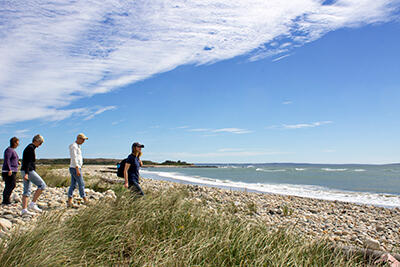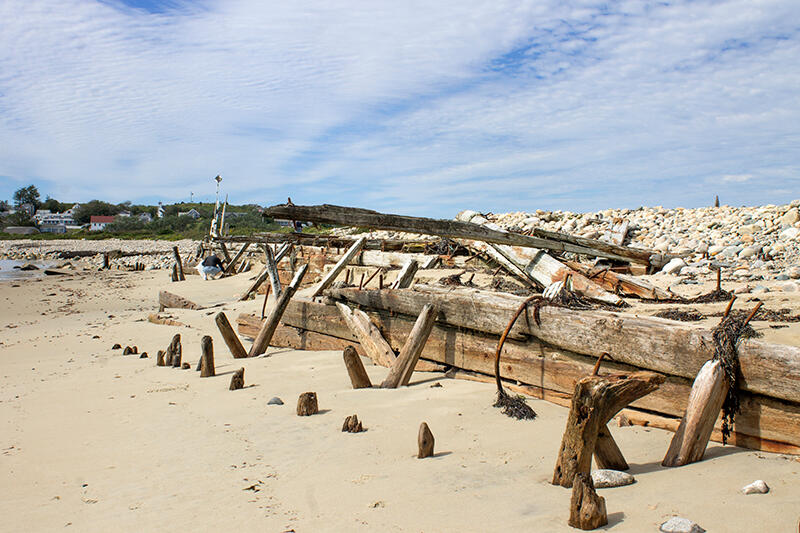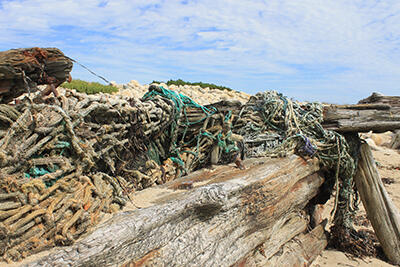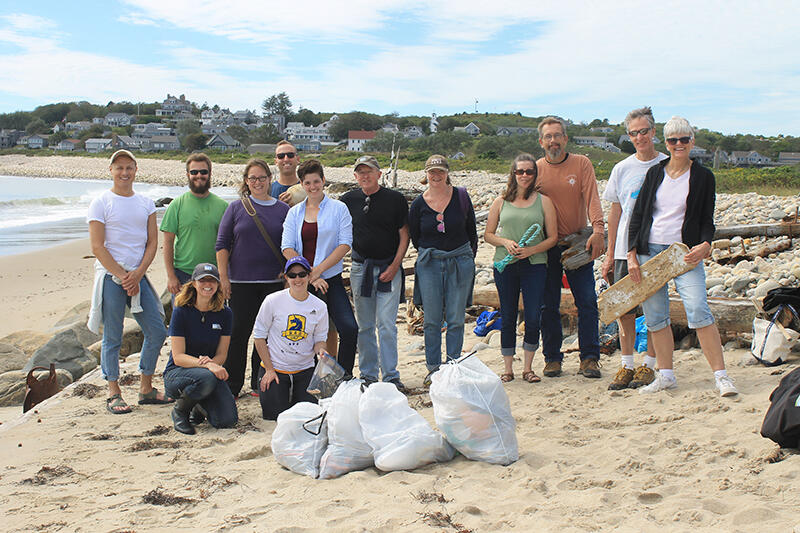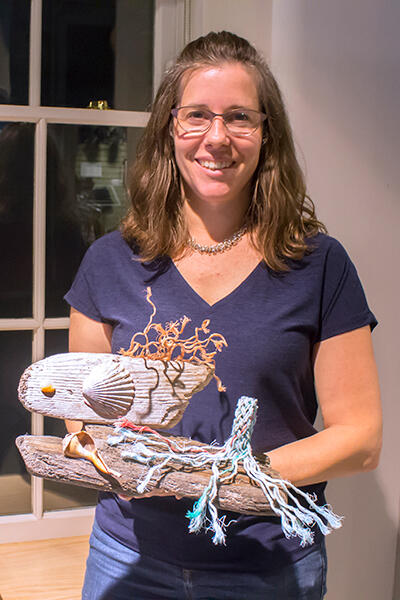Dangling off the end of the Elizabeth Islands—an island chain stretching from the elbow of Cape Cod—Cuttyhunk Island is one of those places that seems to exist in a different time from the rest of the world. It’s still a frontier, caught between the moods of Buzzards Bay to the north, Vineyard Sound to the southeast, and the raw Atlantic from the south. Only around 20 people live on this island year-round.
On a bright day in late September 2018, a group of adventurers braved choppy seas in Buzzards Bay to explore one of this island’s most fascinating beaches, and participate in a very special COASTSWEEP cleanup.
A Cleanup Among the Barges
A little background on this trip: I am the editor of Discover Buzzards Bay, a resource managed by the nonprofit Buzzards Bay Coalition to help residents and visitors alike get outside to learn about, explore, and connect with the outdoor places in our region. In addition to the hundreds of beaches, trails, parks, piers, ponds, and other sites available to anyone who logs onto Discover, I also help organize events that facilitate exploration, bringing people to special places like Cuttyhunk.
On the day we visited, we had a threefold purpose: to explore this unique island, to learn a bit about its ecology and history (guided by the Coalition’s Outdoor Exploration Manager, Rebecca Vasa), and to seek out marine debris shaped and transformed by the ocean. This last aim was guided by New Bedford-based artist John Middleton, who uses these objects to create unique and beautiful pieces of art.
As if that weren’t enough to make this an exceptional COASTSWEEP experience, as soon as we arrived at our destination, Barge’s Beach, we realized that the place we were exploring was unlike any other we’d ever been.
In the late 1940s, 14 wooden barges were run aground on this beach and covered with sand, an effort to repair damage done by a 1944 Nor’easter. Over the last 70-plus years, the ocean has gone to work on these barges: smoothing and bleaching wood, wedging stones and shells into gaps and cracks, and rusting and twisting metal into fantastic shapes. We had come to Barge’s Beach hoping to find materials to create art; we didn’t expect to walk into a piece of art created by nature itself.
Walking among the resurfaced barges, I saw that the ocean had not only reshaped these manmade structures over the years; it had also completely bedecked them with yet more human objects. The barges were entangled in ropes, buoy lines, and nets, with fishing line, wire, and plastic string, all so tangled and weighed down with sand and seaweed that most was impossible to remove. Though the effect was oddly beautiful, it was also disheartening: these barges were a testament to how much trash must be floating out in the ocean and thrown up onto beaches over the decades.
With just over an hour and a half to spend on Barge’s before our ferry boat returned—not nearly enough time!—we collected four trash bags of trash, weighing a total of 36 pounds, as well as numerous freezer bags, canvas totes, and pockets-full of treasures that participants wanted to take home rather than discard. Much of the trash consisted of familiar culprits, such as old plastic bottles and pieces of foam. There were also some unusual finds, like long pieces of PVC piping running through the center of buoys, which must have had some use in fishing or another water activity. Notably, we didn’t find many of the pieces of trash that are common near more populated areas, like cigarette butts, straws, or plastic bags; given Cuttyhunk’s tiny population and position at the mouth of Buzzards Bay, this island receives a unique share of trash, comprised largely of fishing and boating gear.
Marine Debris Transformed
Though we left Cuttyhunk feeling accomplished, there was certainly the sense that there was so much more to be done to reduce marine debris. Fortunately, two weeks later, we met again for an event that felt like a motivation to continue re-visiting these beaches. The Coalition hosted John Middleton at our office for a workshop on creating art from marine debris, which was open to the public as well as anyone who joined us on our cleanup.
Joined by a dozen participants, toting debris they had picked up on local beaches and sometimes collected for years, the workshop produced a set of beautiful, whimsical, completely unique pieces of beach artwork—large and small, abstract and intricate, including a life-size “trash lady” constructed entirely from debris. Just like the barges on Cuttyhunk produced something beautiful from a totally unexpected source, it was remarkable how beautiful marine debris could become.
However, what everyone seemed to take away from the workshop was much more than a piece of artwork. Many participants told us that their art was inspired by the places they found the debris, and from the natural beauty that they saw when exploring outdoors. Several said that they wanted to get back out to the beaches to explore further, pick up more debris, and create more artwork.
As someone whose work seeks to get more people outside and connecting with their surroundings, I couldn’t be more excited to hear this. Cleaning up local beaches, it seems, is a powerhouse for outdoor exploration: it gets people outside and exploring places they might have never gone otherwise; it does something positive for ocean health; and, it creates a powerful connection between a person and their local environment.
Join COASTSWEEP
Visit the COASTSWEEP website to find out how you can join in on the fun and help keep Massachusetts beaches clean by volunteering for an existing cleanup or organizing an event of your own.
Author
Claudia Geib worked for the Massachusetts Office of Coastal Zone Management (CZM) during the summer and fall of 2015 as the COASTSWEEP Social Media and Marketing Intern. Following her time at COASTSWEEP, she earned her master's degree in science writing from the Massachusetts Institute of Technology and spent two years as a freelance science journalist, focusing her reporting on ocean health and marine conservation. She is currently working at the Buzzards Bay Coalition as the editor of Discover Buzzards Bay, a resource that helps people around the South Coast and Cape and Islands connect with outdoor places and learn how to keep them healthy. She is also a sailor, swimmer, and freediver.
